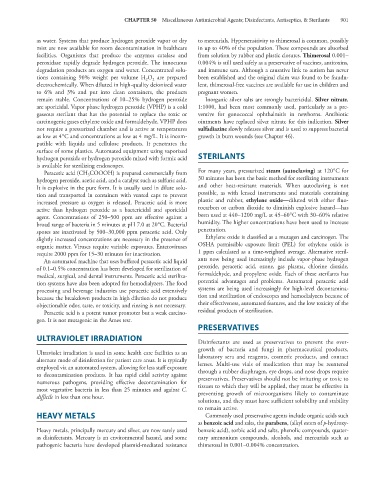Page 915 - Basic _ Clinical Pharmacology ( PDFDrive )
P. 915
CHAPTER 50 Miscellaneous Antimicrobial Agents; Disinfectants, Antiseptics, & Sterilants 901
as water. Systems that produce hydrogen peroxide vapor or dry to mercurials. Hypersensitivity to thimerosal is common, possibly
mist are now available for room decontamination in healthcare in up to 40% of the population. These compounds are absorbed
facilities. Organisms that produce the enzymes catalase and from solution by rubber and plastic closures. Thimerosal 0.001–
peroxidase rapidly degrade hydrogen peroxide. The innocuous 0.004% is still used safely as a preservative of vaccines, antitoxins,
degradation products are oxygen and water. Concentrated solu- and immune sera. Although a causative link to autism has never
tions containing 90% weight per volume H O are prepared been established and the original claim was found to be fraudu-
2
2
electrochemically. When diluted in high-quality deionized water lent, thimerosal-free vaccines are available for use in children and
to 6% and 3% and put into clean containers, the products pregnant women.
remain stable. Concentrations of 10–25% hydrogen peroxide Inorganic silver salts are strongly bactericidal. Silver nitrate,
are sporicidal. Vapor phase hydrogen peroxide (VPHP) is a cold 1:1000, had been most commonly used, particularly as a pre-
gaseous sterilant that has the potential to replace the toxic or ventive for gonococcal ophthalmitis in newborns. Antibiotic
carcinogenic gases ethylene oxide and formaldehyde. VPHP does ointments have replaced silver nitrate for this indication. Silver
not require a pressurized chamber and is active at temperatures sulfadiazine slowly releases silver and is used to suppress bacterial
as low as 4°C and concentrations as low as 4 mg/L. It is incom- growth in burn wounds (see Chapter 46).
patible with liquids and cellulose products. It penetrates the
surface of some plastics. Automated equipment using vaporized
hydrogen peroxide or hydrogen peroxide mixed with formic acid STERILANTS
is available for sterilizing endoscopes.
Peracetic acid (CH COOOH) is prepared commercially from For many years, pressurized steam (autoclaving) at 120°C for
3
hydrogen peroxide, acetic acid, and a catalyst such as sulfuric acid. 30 minutes has been the basic method for sterilizing instruments
It is explosive in the pure form. It is usually used in dilute solu- and other heat-resistant materials. When autoclaving is not
tion and transported in containers with vented caps to prevent possible, as with lensed instruments and materials containing
increased pressure as oxygen is released. Peracetic acid is more plastic and rubber, ethylene oxide—diluted with either fluo-
active than hydrogen peroxide as a bactericidal and sporicidal rocarbon or carbon dioxide to diminish explosive hazard—has
agent. Concentrations of 250–500 ppm are effective against a been used at 440–1200 mg/L at 45–60°C with 30–60% relative
broad range of bacteria in 5 minutes at pH 7.0 at 20°C. Bacterial humidity. The higher concentrations have been used to increase
spores are inactivated by 500–30,000 ppm peracetic acid. Only penetration.
slightly increased concentrations are necessary in the presence of Ethylene oxide is classified as a mutagen and carcinogen. The
organic matter. Viruses require variable exposures. Enteroviruses OSHA permissible exposure limit (PEL) for ethylene oxide is
require 2000 ppm for 15–30 minutes for inactivation. 1 ppm calculated as a time-weighted average. Alternative steril-
An automated machine that uses buffered peracetic acid liquid ants now being used increasingly include vapor-phase hydrogen
of 0.1–0.5% concentration has been developed for sterilization of peroxide, peracetic acid, ozone, gas plasma, chlorine dioxide,
medical, surgical, and dental instruments. Peracetic acid steriliza- formaldehyde, and propylene oxide. Each of these sterilants has
tion systems have also been adopted for hemodialyzers. The food potential advantages and problems. Automated peracetic acid
processing and beverage industries use peracetic acid extensively systems are being used increasingly for high-level decontamina-
because the breakdown products in high dilution do not produce tion and sterilization of endoscopes and hemodialyzers because of
objectionable odor, taste, or toxicity, and rinsing is not necessary. their effectiveness, automated features, and the low toxicity of the
Peracetic acid is a potent tumor promoter but a weak carcino- residual products of sterilization.
gen. It is not mutagenic in the Ames test.
PRESERVATIVES
ULTRAVIOLET IRRADIATION
Disinfectants are used as preservatives to prevent the over-
growth of bacteria and fungi in pharmaceutical products,
Ultraviolet irradiation is used in some health care facilities as an laboratory sera and reagents, cosmetic products, and contact
alternate mode of disinfection for patient care areas. It is typically lenses. Multi-use vials of medication that may be reentered
employed via an automated system, allowing for less staff exposure through a rubber diaphragm, eye drops, and nose drops require
to decontamination products. It has rapid cidal activity against preservatives. Preservatives should not be irritating or toxic to
numerous pathogens, providing effective decontamination for tissues to which they will be applied, they must be effective in
most vegetative bacteria in less than 25 minutes and against C. preventing growth of microorganisms likely to contaminate
difficile in less than one hour.
solutions, and they must have sufficient solubility and stability
to remain active.
HEAVY METALS Commonly used preservative agents include organic acids such
as benzoic acid and salts, the parabens, (alkyl esters of p-hydroxy-
Heavy metals, principally mercury and silver, are now rarely used benzoic acid), sorbic acid and salts, phenolic compounds, quater-
as disinfectants. Mercury is an environmental hazard, and some nary ammonium compounds, alcohols, and mercurials such as
pathogenic bacteria have developed plasmid-mediated resistance thimerosal in 0.001–0.004% concentration.

